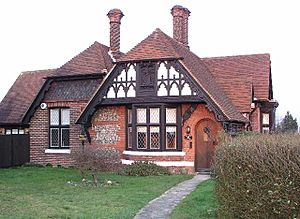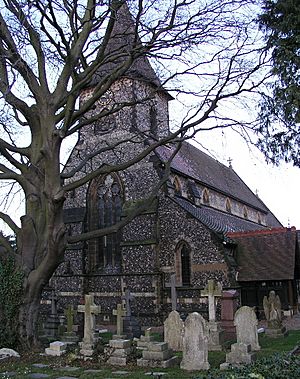Shirley, London facts for kids
Quick facts for kids Shirley |
|
|---|---|
 Shirley Library |
|
| Population | 14,296 (ward, 2011) |
| OS grid reference | TQ361658 |
| • Charing Cross | 10 mi (16 km) NNW |
| London borough | |
| Ceremonial county | Greater London |
| Region | |
| Country | England |
| Sovereign state | United Kingdom |
| Post town | CROYDON |
| Postcode district | CR0 |
| Dialling code | 020 |
| Police | Metropolitan |
| Fire | London |
| Ambulance | London |
| EU Parliament | London |
| UK Parliament |
|
| London Assembly |
|
Shirley is a lively area in south London, England. It is part of the London Borough of Croydon. Shirley is located about ten miles south-southeast of Charing Cross, a famous spot in central London. Before 1965, Shirley was part of the county of Surrey.
The Shirley area has a few different parts. These include Shirley proper, Shirley Oaks to the north, and Upper Shirley to the west. Sometimes, nearby areas like Monks Orchard and Spring Park are also thought of as part of Shirley.
Contents
Shirley's History and Growth
Shirley used to be a quiet place with just a few small villages and farms. This was before the 1930s. Some of these old names, like Spring Park and Monks Orchard, are still used for neighborhoods today.
Monks Orchard is not named after monks. It probably got its name from a family called Monk who once owned the land. In 1854, a man named Lewis Lloyd bought the land. He built a large house and called the whole estate "Monks Orchard" after a local wood.
Monks Orchard House
Lloyd's Monks Orchard House was one of the biggest mansions in the Croydon area. It had 19 bedrooms and many other rooms, including a library. The estate was huge, covering over 1,500 acres. It stretched far in every direction and included other large homes, farms, and even a golf course.
In 1923, the area was described as "delightfully rural." It was seen as a perfect place for country houses not too far from London.
When the estate was sold in 1920, only parts of it found buyers. The rest was offered again in 1924. The City of London Corporation bought this part. They wanted to move the Bethlem Royal Hospital there, which needed more space than its old home in Lambeth.
Building the new hospital started in 1928. Sadly, this meant the old mansion was pulled down. The hospital did not need all the land, so some parts were sold for building new homes. The hospital and its grounds were later moved into the Bromley area in the 1990s.
Building Boom and Green Spaces
In the 1930s, many suburban-style houses were built across Shirley. However, some areas remained open. Shirley Park House, with its large grounds, became a hotel. In 1965, it was bought by the Whitgift Foundation. They built a new building there for Trinity School. Next to the school is Shirley Park Golf Course.
To the south of Shirley, there are large areas of woodland. These include Shirley Hills and Threehalfpenny Wood. You can also find parks and open spaces like Miller’s Pond. In Upper Shirley, very large houses have been built in special estates.
Churches in Shirley
Shirley has three Anglican churches. Shirley Parish Church, called St John the Evangelist, was built in 1856. All Saints' Church on Bridle Road was built in the 1950s and is known for its high-quality design. St George the Martyr on The Glade was also built in the 1950s. There are also other churches, including Shirley Methodist Church and Baptist Churches. Croydon's Synagogue is on Shirley Oaks Road.
Shrublands Estate
After the Second World War, Croydon had a big shortage of homes. The local council decided to buy the golf course land. This area was quickly filled with temporary homes called "prefabs." By 1955, the council planned to develop the area into a new housing estate.
The idea was to create a slightly rural feel. There would be shared grassy areas between the houses. Each house would also have its own private back garden.
The estate was planned to have many play areas for children. Shops, doctors' offices, and a community hall were also part of the plan. A modern idea for the time was that the estate would be a "smokeless zone" from the start.
By 1959, the Shrublands estate was finished. It has stayed mostly the same for almost 50 years. New additions include a multi-ball games court and a family center. Other facilities include a pub called "The Goat" and the Shirley Youth & Community Centre.
Shirley Oaks
Shirley Oaks was originally Shirley Lodge Farm. The old farmhouse, built in the 17th century, was taken down in 1996. There was also a farm lodge on Wickham Road that marked the farm entrance. This road is now called Shirley Oaks Road.
In 1903, the farm was replaced by the Shirley School. This was a special village where children lived in small groups in houses named after flowers and trees. Some of these original buildings are now apartments. Many new houses have also been built. To continue the theme, every road in the area is named alphabetically after a flower. Shirley Oaks is a popular place because it has a special feel and two hectares of open space.
The area is close to the main street. Only two main roads connect it to Shirley and Addiscombe. Shirley Oaks Village is also home to the private Shirley Oaks Hospital.
Shirley Windmill
The tower mill in Shirley was built by Richard Alwen. He built it in 1854 to replace an older mill that had burned down. By 1893, the owner, Alfred Rayson, had to stop using the mill because it was no longer making money. After it closed, the windmill started to fall apart. It was even struck by lightning twice, in 1899 and 1906.
In 1951, the Croydon Corporation bought the mill and its land. The mill was almost torn down when the new John Ruskin School was built. However, it was saved because it is a Grade II listed building. This means it is important and protected. There was also strong public interest in keeping it. The school, now called John Ruskin College, later moved. Houses were then built around the mill.
In 1996, the London Borough of Croydon received a grant of £218,100 from the Heritage Lottery Fund. This money helped to fix up the mill. Now, it can work again and is open for people to visit.
Shirley Windmill is open to the public on the first Sunday of each month from June to October. It also opens in May for National Mills weekend and usually in September for Open House Weekend.
Nearby Places to Explore
- Addington
- Addiscombe
- South Norwood
- Eden Park
- Elmers End
- West Wickham
- Woodside
- Selhurst
Nearest Train and Tram Stations
- Eden Park railway station
- West Wickham railway station
- Elmers End station (for trains and Tramlink services)
- Coombe Lane tram stop
- Norwood Junction railway station
- East Croydon Station
Famous People from Shirley
- Ronnie Corbett: A well-known comedian who lived in Shirley for many years.
- Ben Haenow: A singer who won X Factor. He grew up in Shirley.
- John Maberly: A Member of Parliament and owner of Shirley Park.
- George Pilkington Mills: A famous cyclist.
- John Surtees: A world champion in both motor racing and motorcycle riding. He grew up in Shirley.
- William Wilks: A vicar in Shirley who developed the Shirley poppy, a common garden flower.
- Ian Wright: A famous footballer who used to live in Shirley.
- Tom Wright: An architect who designed the amazing Burj Al Arab building in Dubai.
Images for kids














